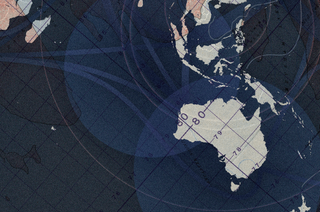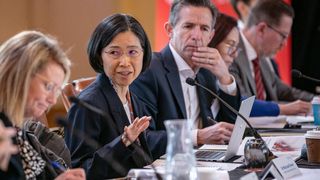Thank you to the US Studies Centre for the invitation and for convening this extremely important dialogue. It is an honour to join you.
I will talk about three things. First is how we got here. Second is what I call China Shock 3.0. Third is the need for an unprecedented level of alignment between Australia, Japan and a broader coalition of the willing.
1) How we got here
Trump tariffs are a symptom, not the root cause. At METI (the Ministry of Economy, Trade and Industry), I had mixed feelings about the WTO (World Trade Organization) — respect for its core functions, but a growing sense of its limits.
Soon after China’s accession, I was working in Washington, DC, when concerns about compliance came up, the advice was, “They’ve just joined — give it time.”
A few years later, back in Tokyo, I travelled frequently to China and learned of the roll-out of the Indigenous Innovation program. Beijing’s toolkit was familiar: joint-venture terms that pulled in know-how, local-content and procurement preferences, and large subsidies building national champions — three levers combined.
China’s 15-year science and technology plan in 2006 stated that truly core technologies in sectors vital to the national economy and national security cannot be purchased. It was a sobering signal.
When I moved to METI’s division in charge of the WTO in 2008, I explored what might be possible to address industrial policy under its rules, but under-reporting and limited transparency made it hard to compel disclosure. It underscored the need for frameworks beyond the WTO, and the TPP (Trans-Pacific Partnership) fits that need. Mike Green — then in Washington — supported efforts to bring Japan into the TPP negotiations, for which I remain grateful.
Momentum grew after the 2010 Senkaku incident. A Chinese trawler collided with a Japan Coast Guard vessel. Japan detained the captain; Beijing demanded his release, detained Japanese businesspeople and rare-earth shipments to Japan were disrupted. Japanese magnet makers started production in China to secure stable supply at the suggestion of the Chinese authorities. By around 2014, production of high-performance rare-earth magnet materials had begun there.
Yes — Japan, the United States and the European Union later won the WTO case against China’s export restrictions. We won the legal case, but industrial outcomes did not follow automatically. In late 2023, Beijing announced export controls on certain high-performance rare-earth magnet manufacturing technologies consistent with confidence in holding that chokepoint. This year, authorities have announced or tightened controls on several critical mineral inputs and related manufacturing know-how — another turn in a three-decade strategy.
In 1992, Deng Xiaoping famously remarked that while the Middle East has oil, China has rare earths. From the 1990s onward, policy pushed not only extraction but — crucially — refining, tightening upstream choke points.
That brings me to point two: systematic efforts to shape entire industrial chains — China Shock 3.0.
2) China Shock 3.0
By the 2010s, the toolkit was in place — sector plans like Made in China 2025, and civil–military fusion channels that allow civilian technology to serve military objectives.
Many firms experienced a similar pattern over time: initial welcome and accelerated approvals; pressure to localise technology; rapid capability catch-up by local champions; and, eventually, displacement of the original partner. No single firm could fully see the macro pattern in advance.
In April 2020, President Xi’s ‘dual circulation’ speech made the intent clearer: for national security, build industrial and supply chains China can control, and draw international chains into dependence. There is extensive evidence that supply chains are used as instruments of statecraft.
Implementation followed: acquire upstream resources overseas, expand refining and other midstream capabilities at home, and build downstream plants in third-country hubs to secure market access and re-export routes. Policy banks supported these moves abroad; export controls on key inputs reinforced leverage where useful.
In parallel, downstream policy drove import substitution — assembly first, then key components. As upstream refining expanded, the two tracks locked together: mines and refineries, then magnets, motors and battery materials, then EVs and wind systems.
That vertical integration is what I mean by China Shock 3.0. It is end-to-end capacity control — from upstream resources to midstream components to downstream systems — and it can impede rival capacity from scaling. If you try to build capacity outside those chains, raw-material supply can tighten, Chinese firms can undercut prices at your layer, and downstream markets can be flooded at very low prices until producing your parts is no longer profitable. The investment case is picked off at the weakest link and neutralised. In effect, it deters capacity from forming. This reflects a coherent long-term strategy to secure leadership in key value chains.
This creates a policy trade-off. If we defend capacity, prices may be higher today. If we do not, capacity shrinks — and prices spike tomorrow. We have seen episodes of below-cost pricing followed by market-power concerns before.
3) The need for unprecedented alignment
Countries will react differently because exposures and politics differ. For resource-rich Australia with a thinner manufacturing base, pressure points include prices, climate goals and export access. Midstream vulnerabilities can feel less urgent. Yet if allied mid- and downstream continue to hollow out, resource exporters face a single-buyer trap.
Time is not on our side. In the first half of this year, Chinese firms accelerated projects in third countries, securing sites, partners and multi-year offtake.
A brief note of hope. Even if Washington’s posture may appear unilateral at times, it has jolted allies awake. Partners are taking on more responsibility and are readier to act together than a few years ago. What earlier outreach could not unlock, this shock has. Washington is already moving — the Department of Defense has worked with MP Materials on domestic rare-earth projects, backed by longer-term commitments. That’s an opening to co-design with allies — so we build scalable, distributed allied capacity — multiple nodes, shared scale, better prices.
So what should we do?
First, preference in public procurement should be given to products from stable, trusted sources, verified by origin labelling and traceability. To help new projects scale, long-term purchase agreements or strategic stockpiles should guarantee a minimum price or quantity during the ramp-up period.
Second, rules should be aligned so they reinforce rather than clash — with coordinated remedies and carve-outs across jurisdictions, shared early-warning systems for capacity/export surges and subsidy footprints and cross-government coordination to avoid stovepipes. Policy should remain coherent so that standards and incentives do not entrench new dependencies via very low-priced downstream imports.
Third, finance should match the shock. Volatility should be priced, public backstops should be paired with private capital, and shared term sheets with synchronised approvals — across EFA (Export Finance Australia), JBIC (Japan Bank for International Cooperation and NEXI (Nippon Export and Investment Insurance) — should be used so projects move from planning to production on a predictable timeline.
If we don’t act now, capacity can be hardwired into China-controlled chains for years.
And a final strategic note. A forcible change to the status quo across the Taiwan Strait would shift the Western Pacific balance and make sea-lane security between Australia and Japan more fragile. We would face more frequent coercion. Freedom and democracy would be compromised even if prosperity seemed to continue.
As technical as it may sound, critical-minerals policy determines whether our clean-energy and digital systems rest on trusted, diversified supply chains — or on coerced dependency. That is ultimately about the kind of world we want to live in. We are at a critical juncture.
To counter the trend toward concentrated economic dominance, we have to pool scale and act together. Think of this as a deterrence-through-resilience program: invest now to deter coercion without provoking conflict. Done right, it is also a growth strategy — dual-use capacity lifts productivity, speeds innovation and creates good jobs across the chain. As a practical anchor, allies could earmark around 1.5% of GDP within defence-related budgets for dual-use supply-chain resilience. It is cheaper than crisis — or war. It will be hard. But if we fail to move together, we risk entrenching a China-centric economic order.
Australia and Japan can move in parallel and welcome the United States as it is ready. Call it Warp Speed 2.0 for allied supply chains.
Australia and Japan are pivotal partners in this crucial endeavour.
Thank you.
The views expressed here are my own, in my personal capacity, and do not represent those of any current or former employers or affiliations.






